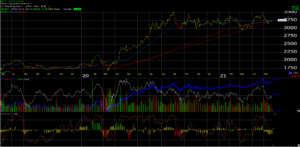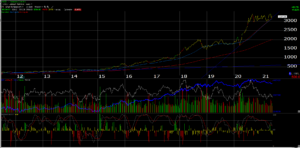This daily chart of Amazon (AMZN) – please click on to expand – shows the stock testing it’s 200-day moving and the uptrend line off the March, 2020 lows. If there is a tech chart (actually Amazon is the largest weighting in the consumer discretionary sector, but you get the point) that reads “precarious” Amazon would be it. For a better perspective perhaps, here is the weekly chart:
If Amazon takes out these support levels, the next big level is all the way down at $2,000 per share.
Three prominent market voices came out last week and were negative on the Technology sector:
- Russ Koesterich of Blackrock is a member of the Global Asset Allocation Team and he did a CNBC interview and was negative on the tech sector. He was negative in a March ’21 interview as well (hope I wasn’t watching a replay) although Russ gave a similar interview in March ’21 on why there were secular reasons to like semiconductors.
- Tom Lee at FundStrat Global Advisors noted that investors probably need to take down their tech overweight in a CNBC interview with Wilfred Frost and Sara Eisen last week. Tom’s market calls this year have been quite accurate although he has been getting more press of late for his Bitcoin prognostications ($100,000 price target by Fundstrat).
- Finally, while maybe not a household name, Gary Morrow, a very good technician often quoted on this blog (@garysmorrow), who posts to the “This Week on Wall Street” blog, is a member of the LifePro Asset Management Team, and that team has cut their Tech weighting to zero as of last week. Their model portfolio was up 100% in 2020, and had only given back 7% this year per one update I read.
Clients can get unhappy when big capital gains are taken all at once, so the LifePro strategy of cleaning out a sector always has ramifications for taxable accounts.
For clients with big taxable accounts. changes are usually made slowly and over a period of months.
Summary / conclusion: Technology is still the largest weighting in the SP 500 as of this past weekend, with a 26.2% market cap weighting within the SP 500 per the IBES by Refinitiv data, so I’m willing to live with any downside for the time being. For the most part, after the June ’21 earnings reports are released, which will be some of the toughest comp’s for tech (with the exception of Apple) this year, the year-over-year compares should start to normalize, and the big 5 Tech companies like Microsoft, Apple, Amazon, Facebook, and Alphabet should retain some of their their market share gains from the pandemic.
Ed Yardeni does great SP 500 earnings work, and Ed has noted that with the March, 2000, peak and the ensuing 80% correction in the Nasdaq and large-cap growth stocks, when Technology reached it’s 33% SP 500 market cap weight in March, 2000, the “earnings weight” of Tech within the SP 500 was just 13%.
Today, with that 23% – 25% tech weighting in the SP 500, the “earnings weight” of the technology sector is much closer to the market cap weight, unlike early 2000.
In other words, the difference between the earnings weight and market cap weight of Technology is nowhere as large in May, 2021 as it was in early 2000.
That’s the big difference.
Still, remember the tech sector could tread water for 12 – 18 months despite good earnings, as “PE’s compress” and the sector remains out of favor.
Looking at EPS and revenue estimates for the Big 5 Tech companies, (and I’ll have an update in early June ’21 with the May 31 estimates), Google’s EPS and revenue revisions following April’s earnings release were nothing short of blow-out revisions. Seriously, you don’t normally see upward revisions like this: on March 31, sell-side consensus EPS was expecting roughly $69 per share for 2021, but the March ’21 quarter beat the consensus by $10 per share ($26 actual vs $15 expected) and the new sell-side consensus EPS estimate as of April 30, 2021 was $87.95 or almost $20 higher after earnings. ( Some of the numbers were rounded for simplicity.)
Apple’s revisions were similar. Microsoft’s “post-earnings” revisions were probably the smallest despite the upside beat.
Take everything you read with a grain of salt and substantial skepticism. The markets can change quickly and many times not for the better. Invest based on your own financial profile and risk tolerance.
Thanks for reading.


